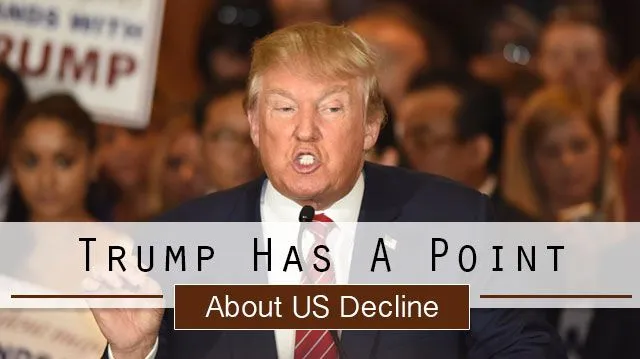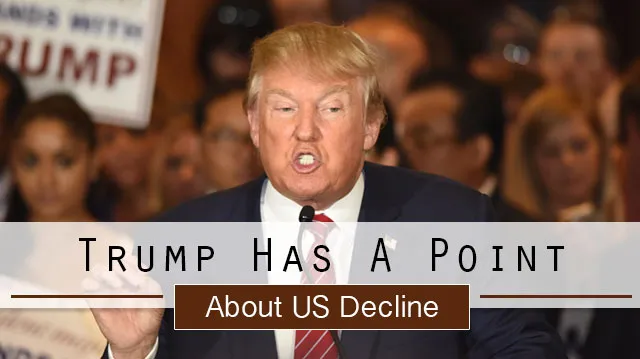
- Share on Facebook55
- Share on Pinterest
- Share on Twitter
Trying to pinpoint and neatly label Donald Trump’s policy prescriptions is a daunting task. Depending on who asks and when, he is ardently opposed to the Affordable Care Act but also supports universal health care and would be open to a system like that of Canada. He supports fully funding Medicare and Social Security but also plans to significantly reduce taxes. He supports a multilateral, cooperative program of foreign policy when it comes to international intervention and security but espouses a decidedly protectionist view of trade policy.
Trump assures voters that every policy is a part of his master plan to, “Make America Great Again.” As Noah Smith of Bloomberg View points out, “You can’t ‘Make America Great Again’ unless America isn’t so great right now.” Indeed, Trump’s entire campaign is based on the idea that American politicians have failed us and that it will take an anti-politician to get us back on course.
Trump’s overall campaign message has wooed his many supporters. As the middle class shrinks, Americans are desperate for economic recovery. Our trade policy has been blamed for job losses, some voters fear the economic and military rise of China, and Trump’s anti-immigrant rhetoric resonates with Americans worried about their own wages and employment opportunities.
As a result, Trump’s policies designed to “Make America Great Again” include trade protectionism, a particularly harsh stance on Chinese-American economic relations and decidedly anti-immigration policy prescriptions.
Protectionist trade policy
While many economists have bought into the idea that all boats rise under a globalizing economy, everyone understood that some restructuring would be necessary. Specific parts of the economy might need a push toward change. As it happened, those parts were overwhelmingly populated by workers in white Middle America.
Trump’s support is highest in counties with less education. It’s also important to note that these are the same counties where closing factories have caused massive job cuts and unemployment.
Trump promises to bring manufacturing jobs back by renegotiating or reneging on the North American Free Trade Agreement (NAFTA), the free trade agreement that many of his supporters blame for American job losses. Whether NAFTA has actually been the cause of our economic woes, however, is broadly contested.
The left-wing Economic Policy Institute finds that 900,000 jobs have been exported to Mexico under NAFTA. The right-leaning US Chamber of Commerce finds that five million jobs have been created by NAFTA. Both claims could be partly true; restructuring requires some jobs to be lost while others are gained.
Scholars also argue that many jobs have been lost independently of free trade deals. They point to technological advances and the country’s continuing shift toward a service economy as the primary culprit behind manufacturing’s decline.
It is important to note that manufacturing jobs actually rose for six years following the implementation of NAFTA. They actually began to fall in 2001, coinciding with China’s entry to the World Trade Organization and the culmination of market-based reforms in that country.
Playing hardball with China
Trump has things to say about trade with China, too. He is aggressively critical of their currency valuation, claiming that the yuan is undervalued. “If you look at the way China in particular takes advantage of the U.S. — it’s through currency manipulation,” he asserts. Ten years ago, Trump would have had a point. An undervalued currency in China makes their manufactured goods artificially less expensive, which in turns makes our exports less competitive.
What Trump doesn’t mention is that currency manipulation in China has all but stopped. The yuan has slowly strengthened against the dollar for a decade. China’s contested currency devaluation in 2015 was not an act of economic war. It placed the yuan in line with International Monetary Fund guidelines. This ultimately allowed the yuan to be admitted as a global reserve currency, a long-time goal of the Chinese government, and puts it on equal footing with other major world currencies.
Trump’s proposed solution to the perceived problem — to raise high tariffs on goods coming out of China — horrifies economists on both sides of the political spectrum. Though China is not a beacon of free trade excellence, the country has made massive strides toward adhering to international standards. Alongside the US, it also has suffered restructuring costs in a good faith effort to join the international economy. Economists fear a US tariff now would kick off a trade war, plunging the world into recession.
Trump’s prescriptions on free trade and China’s perceived currency manipulation closely mirror viewpoints held by Bernie Sanders, more so than any other Republican candidate. Where Sanders and Trump disagree, however, is immigration policy.
Immigration policy
A strict immigration policy is one of Trump’s signature proposals designed to “Make America Great Again.” Trump argues that immigrants are stealing jobs from Americans. He wants to build a wall along our southern border with Mexico, deport all illegal immigrants and crack down on current visas. He would require H1-B visas be issued only for those taking higher paying engineering jobs, leaving entry-level employment for Americans. He also plans to terminate J-1 visas for foreign youth in an effort to support jobs for US inner-city youth.
Economists on both sides of the political spectrum have renounced Trump’s application of economic principles when applied to immigration in America. The vast majority of studies cite a net gain for the US economy. Immigrants pay into our Social Security system, lower consumer prices and create as many jobs as they occupy.
 Kenneth Megan of the Bipartisan Policy Center best sums up the flawed logic behind anti-immigration rhetoric: “Blaming immigration for declining employment ultimately rests on the flawed belief that economies can only produce a fixed number of jobs and that for every job occupied by an immigrant, a native-born worker must be unemployed.”
Kenneth Megan of the Bipartisan Policy Center best sums up the flawed logic behind anti-immigration rhetoric: “Blaming immigration for declining employment ultimately rests on the flawed belief that economies can only produce a fixed number of jobs and that for every job occupied by an immigrant, a native-born worker must be unemployed.”
Independent of the immigration debate, Trump’s major policies are financially untenable.
Even if he could convince Mexico to pay for a wall (yes, that really is his plan), deporting 11 million people is an expensive task. In conjunction with his promises to lower the deficit, cut taxes and fully fund Medicare and Social Security, mass deportation is virtually impossible.
One example of his insanely poor accounting skills: Trump says he will pay for permanent increased border control by cracking down on tax refunds to illegal immigrants. He is also planning to deport all illegal immigrants. Though it is possible to receive more in refunds than one has paid into the system, this is not the norm. Commandeering the tax refunds of people no longer earning US wages or sending those wages to the US government is going to be tricky.
As problematic as all this is, Trump does have a point: Working-class Americans are hurting for a variety of reasons, and the politician who not only addresses the problem but comes up with workable solutions is likely to receive their support.
What do you think of Trump’s campaign pledges?
—Erin Wildermuth
Erin is a freelance writer, photographer and filmmaker. She is passionate about moving beyond party politics to identify pragmatic solutions to social, economic and political problems. Her writing has appeared in the Washington Times, the American Spectator, Doublethink and Scuba Diver Magazine. She spends her free time scuba diving, snowboarding and ravenously reading popular nonfiction. Erin holds a master’s degree in International Political Economy from the London School of Economics.
Sources:
https://www.donaldjtrump.com/
http://www.bloombergview.com/articles/2016-03-03/donald-trump-has-a-point-about-american-decline
http://www.breitbart.com/big-government/2015/06/17/the-man-with-a-plan-donald-trumps-5-part-strategy-to-make-america-great-again
http://www.theguardian.com/commentisfree/2016/mar/07/donald-trump-why-americans-support
https://www.washingtonpost.com/news/wonk/wp/2016/03/04/death-predicts-whether-people-vote-for-donald-trump
http://money.cnn.com/2016/03/15/investing/donald-trump-trade-oped/index.html
http://money.cnn.com/2016/03/09/news/economy/trade-jobs-middle-class/index.html?iid=EL
http://www.economist.com/node/21541408
http://www.brookings.edu/blogs/up-front/posts/2013/01/29-immigration-greenstone-looney
http://time.com/money/4129837/china-currency-manipulation-imf-yuan
http://www.thefiscaltimes.com/2015/04/27/Stop-Currency-Manipulation-New-Battle-Cry-Democrats
http://blogs.wsj.com/washwire/2015/05/22/what-you-may-not-know-about-china-and-currency-manipulation
http://america.aljazeera.com/watch/shows/Ali-Velshi-On-Target/articles/2015/8/19/chinas-currency-moves-akin-to-us-printing-dollars.html
http://www.bloomberg.com/news/articles/2015-11-30/imf-backs-yuan-in-reserve-currency-club-after-rejection-in-2010
http://www.cnbc.com/2016/03/10/trump-trade-plans-could-cause-global-recession-experts.html
https://news.vice.com/article/unauthorized-immigrants-paid-100-billion-into-social-security-over-last-decade
http://thehill.com/blogs/congress-blog/foreign-policy/203984-illegal-immigrants-benefit-the-us-economy
http://www.thefiscaltimes.com/2015/08/26/Are-Immigrants-Really-Taking-American-Jobs
http://www.nytimes.com/2015/03/29/magazine/debunking-the-myth-of-the-job-stealing-immigrant.html?_r=0
http://www.wthr.com/story/19241488/inspector-general-calls-irs-problems-shocking-and-disappointing
https://news.vice.com/article/unauthorized-immigrants-paid-100-billion-into-social-security-over-last-decade
http://thehill.com/blogs/congress-blog/foreign-policy/203984-illegal-immigrants-benefit-the-us-economy
http://www.thefiscaltimes.com/2015/08/26/Are-Immigrants-Really-Taking-American-Jobs
http://www.nytimes.com/2015/03/29/magazine/debunking-the-myth-of-the-job-stealing-immigrant.html?_r=0
http://www.wthr.com/story/19241488/inspector-general-calls-irs-problems-shocking-and-disappointing
- Share on Facebook55
- Share on Pinterest
- Share on Twitter

